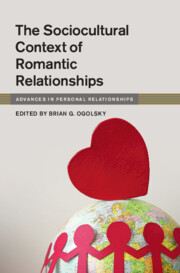Book contents
- The Sociocultural Context of Romantic Relationships
- Advances in Personal Relationships
- The Sociocultural Context of Romantic Relationships
- Copyright page
- Contents
- Contributors
- 1 The Sociocultural Context of Romantic Relationships
- 2 Systemic Racism and Romantic Relationships
- 3 Sociocultural Perspectives on Romantic Relationships
- 4 Gender and Heteronormativity in Romantic Relationships
- 5 Social Class, Neighborhoods, and Romantic Relationships
- 6 Religion and Spirituality in Romantic Relationships
- 7 The Importance of Work in Romantic Relationships
- 8 History and Cohort Effects in Romantic Relationships
- 9 The Legal Meaning of Sex (and Romantic Relationships)
- 10 Romantic Relationships and Traditional Media
- 11 Romantic Relationships and Social Media
- 12 Situating Latinx Immigrant Romantic Relationships in the Context of Illegality
- 13 Romantic Relationships during a Global Pandemic
- Index
- References
13 - Romantic Relationships during a Global Pandemic
Published online by Cambridge University Press: 19 October 2023
- The Sociocultural Context of Romantic Relationships
- Advances in Personal Relationships
- The Sociocultural Context of Romantic Relationships
- Copyright page
- Contents
- Contributors
- 1 The Sociocultural Context of Romantic Relationships
- 2 Systemic Racism and Romantic Relationships
- 3 Sociocultural Perspectives on Romantic Relationships
- 4 Gender and Heteronormativity in Romantic Relationships
- 5 Social Class, Neighborhoods, and Romantic Relationships
- 6 Religion and Spirituality in Romantic Relationships
- 7 The Importance of Work in Romantic Relationships
- 8 History and Cohort Effects in Romantic Relationships
- 9 The Legal Meaning of Sex (and Romantic Relationships)
- 10 Romantic Relationships and Traditional Media
- 11 Romantic Relationships and Social Media
- 12 Situating Latinx Immigrant Romantic Relationships in the Context of Illegality
- 13 Romantic Relationships during a Global Pandemic
- Index
- References
Summary
Stress associated with the COVID-19 pandemic can threaten the ability to successfully maintain established romantic relationships as well as navigate the initiation and development of new relationships. Drawing on the vulnerability-stress-adaptation (VSA) model, we propose that the extent to which pandemic-related stress will undermine couples’ relationships, as well as the initiation of new relationships, will depend on the amount and severity of pandemic-related and preexisting levels of stress combined with enduring personal vulnerabilities such as attachment insecurity. We review a growing body of research examining relationship processes and functioning prior to and during the initial stages of the pandemic that provides evidence consistent with this framework and draws on related research suggesting routes to minimize relationship disruptions and promote resilience. In addition, we review newly emerging research examining how pandemic-related stress might impact the initiation of relationships. Finally, we discuss several directions for future research to facilitate an understanding of the longer-term implications of the pandemic for ongoing and newly developing romantic relationships.
- Type
- Chapter
- Information
- The Sociocultural Context of Romantic Relationships , pp. 247 - 272Publisher: Cambridge University PressPrint publication year: 2023
References
- 1
- Cited by



